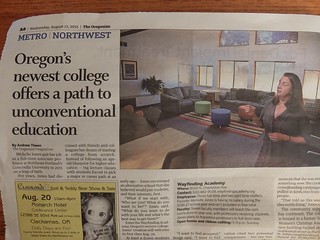The "two teachers per classroom" movement is addressing itself to the student:teacher ratio issue in a way that requires less floor space. We may still cram 30-40 students into the room, but we have two teachers in charge.
In practice, the teachers do not always co-present. In a lab setting, both might walk around to the stations, helping individuals and teams. Or one teacher goes to code school, if a STEM teacher, or even an English teacher brushing up on grammar and typography, fonts and the like i.e. HTML + CSS. Then they switch and the other teacher gets PD (professional development).
However, we've learned from sportscasting that two engaged in banter, repartee, dialog, may be far more enlightening than a lecture format. Have two geeks chattering, with an eye towards inclusivity, having students chime in, and you have a new model for bootstrapping into fluency, as a beneficiary of this "sportscaster" format.
I also like the "talk show host interview" format and plan to use that more in my classrooms. I do both "brick and mortar" and "virtual" appearances. For years, my mode was asynchronous, meaning student work would queue and I'd "slay the queue" (evaluate submissions), either marking them "done" or "in need of more work".
That was our "grading system": you keep chipping away until the mentor says it's OK, and is able to back up those decisions with reference to specific criteria i.e. it's not just subjective BS. This was Python programming; I'm not saying every discipline is able to communicate itself so much in this way.
More recently, my mode is "radio show broadcaster" in a closed circuit television type environment. We have about twenty or so students, able to ask questions in real time. Mostly they see a talking head (mine) in a window, with my desktop filling their window or screen.
I give them lots of privacy and don't turn on their cameras unless they're asking to be put on. I've been looking forward to such classrooms, so I'm not complaining now that I'm getting the opportunity to use them.
Deke the Geek just left a copy of The Oregonian, Metro Section, in my box. I'll be going through that this morning, as the focus is on education this time. I was on the front page of the Metro Section once, in the 1980s, holding a Fuller Projection on a post card.
Another time they featured me as a local futurist. I was anticipating "hypertext kiosks" in local hospitals, where people could browse about insurance plans. Sure enough, within some years, Providence Health System had precisely that.
In practice, the teachers do not always co-present. In a lab setting, both might walk around to the stations, helping individuals and teams. Or one teacher goes to code school, if a STEM teacher, or even an English teacher brushing up on grammar and typography, fonts and the like i.e. HTML + CSS. Then they switch and the other teacher gets PD (professional development).
However, we've learned from sportscasting that two engaged in banter, repartee, dialog, may be far more enlightening than a lecture format. Have two geeks chattering, with an eye towards inclusivity, having students chime in, and you have a new model for bootstrapping into fluency, as a beneficiary of this "sportscaster" format.
I also like the "talk show host interview" format and plan to use that more in my classrooms. I do both "brick and mortar" and "virtual" appearances. For years, my mode was asynchronous, meaning student work would queue and I'd "slay the queue" (evaluate submissions), either marking them "done" or "in need of more work".
Two teachers per classroom: think of sportscasters, two people fluent in whatever shoptalk, cluing the others.. https://t.co/2T7edboL5s— Kirby Urner (@4DsolutionsPDX) August 18, 2016
That was our "grading system": you keep chipping away until the mentor says it's OK, and is able to back up those decisions with reference to specific criteria i.e. it's not just subjective BS. This was Python programming; I'm not saying every discipline is able to communicate itself so much in this way.
More recently, my mode is "radio show broadcaster" in a closed circuit television type environment. We have about twenty or so students, able to ask questions in real time. Mostly they see a talking head (mine) in a window, with my desktop filling their window or screen.
I give them lots of privacy and don't turn on their cameras unless they're asking to be put on. I've been looking forward to such classrooms, so I'm not complaining now that I'm getting the opportunity to use them.
Deke the Geek just left a copy of The Oregonian, Metro Section, in my box. I'll be going through that this morning, as the focus is on education this time. I was on the front page of the Metro Section once, in the 1980s, holding a Fuller Projection on a post card.
Another time they featured me as a local futurist. I was anticipating "hypertext kiosks" in local hospitals, where people could browse about insurance plans. Sure enough, within some years, Providence Health System had precisely that.

